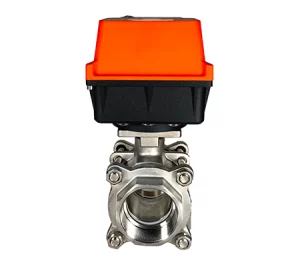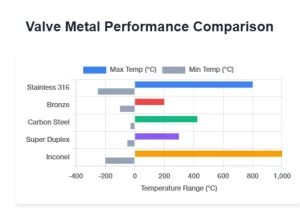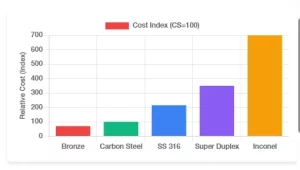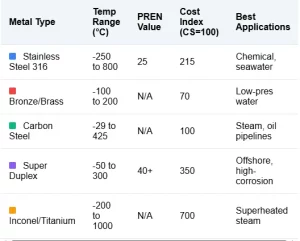

Valve Metal Performance Comparison

Cost index (CS=100)

Choosing the right metal for your valves can mean the difference between a system that runs smoothly for years and one that fails when you need it most. Every day, industrial systems face the
same problem: valves made from the wrong materials corrode, leak, and break down under pressure.
When valves fail, the
situation gets worse fast. Production stops, repairs cost money, and safety risks grow. A single wrong material choice can lead to dangerous leaks or total system shutdown.
The
solution is simple: match the right valve metal to your specific application needs. With proper material selection based on scientific data and industry standards, you can
ensure long-term performance and avoid costly failures.
Why Valve Material Selection Matters
Valves control the flow of liquids and gases in pipes. The
metal used to make these valves must stand up to:
- High pressure
- Extreme temperatures
- Corrosive chemicals
- Constant use
- Harsh environments
Poor valve material choices lead to:
- Leaks
- Costly downtime
- Safety hazards
- Frequent replacements
- System inefficiency
Key Decision Factors for Valve Metal Selection
Temperature Considerations
The temperature of your system affects how valve metals perform. Some metals get weak when hot. Others get brittle when cold.
Temperature ranges for common valve metals:
| Metal |
Low Temp Limit (°C) |
High Temp Limit (°C) |
| Bronze/Brass |
-100 |
200 |
| Carbon Steel |
-29 |
425 |
| Stainless Steel 316 |
-250 |
800 |
| Duplex/Super Duplex |
-50 |
300 |
| Inconel/Titanium |
-200 |
1000 |
For
cryogenic applications where temperatures drop very low, stainless steel and special alloys work best. Systems with
smart water valves need materials that handle both hot and cold conditions reliably.
Pressure Ratings
Valve pressure capacity depends on the metal strength. Different metals can handle different pressure levels.
ANSI pressure classes link to metal strength:
- Class 150: Up to 275 PSI
- Class 300: Up to 740 PSI
- Class 600: Up to 1480 PSI
- Class 900: Up to 2220 PSI
Carbon steel valves offer high tensile strength (70-100 ksi) and pressure ratings over 6000 psi. This makes them good for high-pressure steam and oil systems.
Modern intelligent valves combine smart control with strong metals to manage pressure automatically.
Corrosion Resistance
Fluids passing through valves can eat away at metals. This is called corrosion. Some metals resist corrosion better than others.
pH levels affect metal corrosion:
- Acidic (pH 0-6): Need high corrosion resistance
- Neutral (pH 7): Less corrosive
- Basic (pH 8-14): Can be corrosive to some metals
The
PREN value (Pitting Resistance Equivalent Number) shows how well a metal fights corrosion:
- Stainless Steel 304: PREN = 18-20
- Stainless Steel 316: PREN = 24-26
- Super Duplex: PREN > 40
Higher PREN numbers mean better corrosion resistance.
Metal Comparison Guide for Valves
This detailed table shows which metals work best for different valve applications:
| Metal Type |
Best Applications |
Key Advantages |
Limitations & Failures |
Typical Cost |
| Stainless Steel 316 |
Chemical processing, seawater |
Superior chloride resistance (PREN >25), Resists pitting/crevice corrosion |
Vulnerable to SCC in high chloride + high temp environments |
Medium-High |
| Bronze/Brass |
Low-pressure water systems |
Low cost (30-50% cheaper than SS), Easy to machine |
Dezincification in acidic water (pH<7), Weak above 150°C |
Low |
| Carbon Steel |
Steam systems, oil pipelines |
High strength (70-100 ksi), Pressure rating over 6000 psi |
Sulfide stress cracking in H₂S environments, Needs corrosion coatings |
Low |
| Duplex/Super Duplex |
Offshore, high-corrosion |
2x yield strength vs 316 SS, PREN >40 for extreme chloride resistance |
Poor below -50°C, Embrittlement at 475°C |
High |
| Inconel/Titanium |
Power plants, superheated steam |
Maintains strength at 800°C+, Zero corrosion scaling |
6-8x higher cost than stainless steel |
Very High |
Stainless Steel Valves
Stainless steel valve options include many grades:
- 304: Good for mild conditions
- 316/316L: Better for corrosive fluids
- 317L: Enhanced corrosion resistance
- 321: Good for high temperatures
316 stainless steel works well for most water applications. It contains:
- 16-18% chromium
- 10-14% nickel
- 2-3% molybdenum (key for corrosion resistance)
For
marine environments, stainless steel valves with proper sealing materials prevent seawater damage.
Flow regulating valves made from stainless steel provide precise control in corrosive settings.
[caption id="attachment_909" align="alignnone" width="300"]

Ball Valve[/caption]
Bronze and Brass Valves
Bronze and brass valves cost less than stainless steel. They work well for:
- Drinking water systems
- Low-pressure applications
- Non-corrosive environments
- Residential plumbing
Bronze composition typically includes:
- 85-90% copper
- 5-10% tin
- Small amounts of zinc, lead, or nickel
These valves cost 30-50% less than stainless steel but cannot handle the same harsh conditions.
Carbon Steel Valves
Carbon steel valves offer:
- High strength at high temperatures
- Good value for steam systems
- Excellent pressure handling
Common
carbon steel valve grades:
- WCB: Standard carbon steel
- WCC: Better low-temperature toughness
- LCB: Low-carbon for colder applications
Carbon steel valves require protective coatings to prevent rust and corrosion in most environments.
Duplex and Super Duplex Stainless Steel
Duplex stainless steel combines:
- Strength of ferritic steels
- Corrosion resistance of austenitic steels
Super duplex valves last 15+ years vs 5-8 years for standard 316 SS in offshore drilling. They show extremely low 0.02 mm/yr corrosion rates in high-chloride environments.
Special Alloys (Inconel, Monel, Hastelloy)
Special alloys for extreme conditions include:
- Inconel: For very high temperatures
- Monel: For acids and seawater
- Hastelloy: For severely corrosive chemicals
These alloys cost 6-8 times more than stainless steel but last much longer in harsh settings.
[caption id="attachment_2877" align="alignnone" width="300"]

Valve Metal Performance Comparison[/caption]
[caption id="attachment_2878" align="alignnone" width="300"]

Cost index (CS=100)[/caption]
[caption id="attachment_2876" align="alignnone" width="300"]

Metal Type[/caption]
Industry-Specific Recommendations
Oil and Gas Industry
Oil and gas applications need:
- NACE MR0175 compliance for sour service
- High-pressure ratings
- Resistance to H₂S and CO₂
Critical finding: Carbon steel valves without NACE MR0175 compliance show 85% failure rate in sour gas service within 2 years.
Chemical Processing
Chemical processing valves must resist:
- Strong acids
- Caustics
- Oxidizing agents
- Chlorinated compounds
Alloy 20 and Hastelloy C valves work well for chemical applications. Special sealing materials prevent leaks of dangerous chemicals.
Water and Wastewater
Water system valves should:
- Resist chlorine and chloramines
- Meet potable water standards
- Prevent bacterial growth
- Handle varying pH levels
Brass and bronze valves work well for clean water systems, while stainless steel fits better for wastewater with its aggressive chemicals.
Smart water valves offer improved efficiency for water management systems.
Power Generation
Power plant valves face:
- Super-heated steam
- High pressures
- Temperature cycling
- Long service requirements
Inconel trim components extend valve life by 300% in 540°C supercritical steam systems. Nuclear power plants mandate Inconel 625 for safety valves to prevent thermally induced cracking.
Failure Case Studies and Lessons
Case Study 1: Seawater Valve Failure
A coastal chemical plant used 304 stainless steel valves in a seawater cooling system. Within 18 months, several valves failed due to chloride stress corrosion cracking.
Root cause: Wrong metal choice for high chlorides
Solution: Replaced with super duplex valves with PREN >40
Result: No failures in 5+ years, despite higher initial cost
Case Study 2: Steam System Breakdown
A food processing plant faced repeated valve failures in their steam system:
Problem: Carbon steel valves were rapidly corroding
Agitating factor: Condensate return line had acidic pH of 5.2
Solution: Switched to 316 stainless steel valves with proper trim
Cost impact: Initial cost increased by 200%, but lifetime cost reduced by 60%
Case Study 3: Mixed Metal Corrosion
A building heating system used a mix of bronze and stainless steel valves:
Issue: Accelerated corrosion at the junction points
Scientific cause: Galvanic corrosion between dissimilar metals
Solution: Used all bronze valves for the system or installed dielectric unions
Practical Implementation Guide
Step 1: Analyze Your System Requirements
First, know your system needs:
- Fluid type: What flows through your pipes?
- Temperature range: Highest and lowest temperatures
- Pressure: Maximum system pressure
- Special conditions: Vibration, outdoor exposure, etc.
Step 2: Match Material to Application
Use this buyer’s checklist:
- Verify fluid chemistry (pH, chlorides, H₂S)
- Match temperature needs to material limits
- Ensure pressure rating meets system requirements
- Check for industry compliance needs (NACE, ASME, etc.)
- Consider maintenance access and frequency
Step 3: Consider Total Cost of Ownership
Initial cost vs.
lifetime cost matters:
| Material |
Initial Cost (vs CS*) |
Lifetime Cost Reduction |
| Super Duplex |
300-400% |
40-60% (20-yr cycle) |
| Titanium |
600-800% |
35% (extreme chemical applications) |
| Stainless 316 |
180-250% |
30% (standard applications) |
* Carbon steel baseline
A valve that costs more up front but lasts longer often saves money.
Special Considerations for Modern Systems
Smart Valve Integration
Today’s systems often use
smart valves with electronic controls. These valves need metals that:
- Work with sensors
- Handle electrical components
- Resist electromagnetic interference
- Maintain precision over time
Smart valve material selection must consider both traditional factors and compatibility with control systems.
Energy Efficiency Factors
Valve material affects energy use through:
- Flow characteristics
- Thermal conductivity
- Weight (affecting actuator needs)
- Surface finish
Pressure regulating valves with proper materials optimize system efficiency and reduce energy consumption.
Environmental and Safety Standards
Modern valves must meet strict standards:
- Lead-free requirements for drinking water
- Low emissions for volatile fluids
- Fire-safe designs for risky applications
- REACH compliance for chemical safety
Material Science Insights
Metallurgical Properties
The
microscopic structure of valve metals affects performance:
- Grain size: Smaller grains = stronger metal
- Phase balance: Mix of structures for better properties
- Inclusion content: Fewer inclusions = less corrosion sites
- Heat treatment: Proper heating improves metal properties
Surface Treatments and Coatings
Surface treatments enhance valve performance:
- Nitriding: Hardens surface
- Electropolishing: Smoother finish, better flow
- PTFE coating: Reduces friction
- Hard chrome plating: Increases wear resistance
Decision Framework
When choosing valve metals, follow this path:
- Startwith your fluid type
- Check temperature rangeneeds
- Verify pressure requirements
- Consider corrosion factors
- Check industry standards
- Evaluate cost factors
- Choose optimal material
Conclusion
No single “best” valve metal exists for all applications. The right choice always depends on specific conditions, fluid properties, and system requirements.
Scientific material selection based on data prevents costly failures and ensures long-term performance. By matching valve materials to application needs, you create safer, more efficient, and more reliable systems.
The
initial investment in proper valve materials pays off through:
- Reduced maintenance costs
- Fewer emergency shutdowns
- Extended system life
- Improved safety profile
- Better operational efficiency
Remember: A valve is only as good as the metal it’s made from and how well that metal matches your specific application needs.
Technical References
- ASME B16.34: Valves - Flanged, Threaded, and Welding End
- NACE MR0175/ISO 15156: Materials for use in H₂S-containing environments
- ASTM A351: Standard Specification for Casting, Austenitic, Austenitic-Ferritic for Pressure-Containing Parts
- API 600: Steel Gate Valves - Flanged and Butt-welding Ends
- AWWA C504: Rubber-Seated Butterfly Valves
By understanding the science of valve materials and matching them to your specific needs, you ensure optimal performance, safety, and value for your industrial systems.
string(111) "https://www.navarchjncn.com/news/common-problems-with-electric-actuators-and-solutions-a-troubleshooting-guide/"




 Ball Valve[/caption]
Ball Valve[/caption]
 Valve Metal Performance Comparison[/caption]
[caption id="attachment_2878" align="alignnone" width="300"]
Valve Metal Performance Comparison[/caption]
[caption id="attachment_2878" align="alignnone" width="300"] Cost index (CS=100)[/caption]
[caption id="attachment_2876" align="alignnone" width="300"]
Cost index (CS=100)[/caption]
[caption id="attachment_2876" align="alignnone" width="300"] Metal Type[/caption]
Metal Type[/caption]